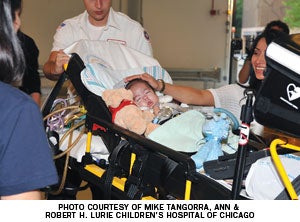Safe move to new hospital completes long journey
 How do you safely move 126 children as young as newborns, including many requiring critical care, from one hospital to another a few miles away? You move them very carefully and only after years of highly detailed planning.
How do you safely move 126 children as young as newborns, including many requiring critical care, from one hospital to another a few miles away? You move them very carefully and only after years of highly detailed planning.
It's also essential to have a lot of smart and skilled people involved every step of the way. Oh, and having plenty of experience transporting young patients from other hospitals certainly helps build confidence.
If there's an example of how to move young patients safely from an aging facility to a new $855 million, 1.25 million-square-foot, state-of-the-art hospital, the clinicians and staff at Ann & Robert H. Lurie Children's Hospital of Chicago not only wrote the game plan, they executed it flawlessly on June 9.
"Yes, we had a very successful move — it was wonderful," says Maureen Mahoney, R.N., chief of new hospital transition and occupancy planning at the hospital.
Planning for what took 14 hours or so to accomplish began three years ago, says Mahoney, and that's one of the keys to the successful transition. Her mantra for the move: "Plan well, plan early and be inclusive."
Being inclusive meant ensuring that physicians and nurses as well as patients and their families provided input as the hospital sorted through the multitude of details that helped make the move seamless, she says.
Getting to that point required working out answers to a long list of questions. How many ambulances would be needed and what route would they take to the new hospital? How would they safely transfer patients from their beds to the ambulance? In what order would the patients be moved? What level of care would be required for each patient?
After getting staff input, Mahoney developed and coordinated the plan with the help of her transition team members and a patient move committee headed up by Sherri Ewing, R.N., NEA-BC, associate chief nurse executive, and Ranna Rozenfeld, M.D., a critical care physician.
Others were tasked with relocating staff and moving furniture, IT hardware, more than 4,000 pieces of medical equipment and other "stuff" to the new site, she says. Patient safety came first at all times.
"Our primary guiding principle was the safety of our patients more than anything. Anything we did we always challenged ourselves to say, 'Is this safe for the patient?'" she adds.
The hospital reached out to key city departments two years prior to the move for help in coordinating an expedient route to the new hospital for the ambulances. Incident command centers were set up at both hospitals to monitor the move and allow for emergency communication with the city if necessary, she says.
To reduce anxiety for the children and their families, the hospital developed a video that explained what to expect on the transition day and made sure one nurse accompanied each child to the new hospital.
Staff were confident in meeting the challenges posed by the transition because they already had years of experience moving thousands of children from other hospitals to the now closed Children's Memorial Hospital.
"The hospital transfers patients all the time. We have a critical care transport team that goes out and picks up patients from all over the Chicago area and sometimes Downstate," she says. Even so, the hospital held multiple mock moves to test every detail in preparation for the June 9 transition.
Mahoney and all involved are proud of what they accomplished. "To see this come to fruition has been a joy for all of us," she says. "For me, it's been a privilege and honor to work on this project."




